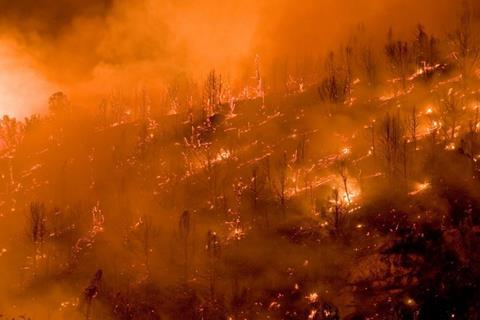Whilst there is not enough evidence to conclude that warming climates alone are responsible for the rising uninsured losses from secondary peril events, climate change is certainly a contributing factor.
Absent a formal definition, industry practice has been to consider secondary perils as high-frequency, low-to-medium severity loss events. Secondary perils can happen on an independent basis, such as drought or wildfires, or they can be secondary effects of primary perils like torrential rainfall or storm surges associated with tropical cyclones
According to Swiss Re Institute’s annual sigma review of natural catastrophes and man-made disasters, more than 60 per cent of the USD 76 billion of insured natural catastrophe losses in 2018 were due to ‘secondary peril’ events. Secondary perils were the primary loss drivers once more in 2019. And once again, secondary perils caused most catastrophe losses in the first half of 2020
Alex Pui, Head of Nat Cat APAC at Swiss Re Corporate Solutions explains: “The total economic losses from Californian wildfires in 2018/19 eclipsed the losses from Typhoon Jebi and Hurricane Michael. While it was a muted year for losses generally, it shows that secondary perils can also be large loss drivers.” .”
The impacts of climate change
Whilst there is not enough evidence to conclude that warming climates alone are responsible for the rising uninsured losses from secondary peril events, climate change is certainly a contributing factor. The increased frequency and severity of warm and dry conditions of recent years have been conducive to heightening the risk of wildfires and drought occurrence.

Pui says: “2009 to 2019 was the warmest decade on record, by a significant margin. As the earth atmosphere warms, its moisture holding capacity also increases and results in a more intense hydrological cycle. This is turn changes the underlying risk profile of storms and subsequently, floods. You get more frequent events and more violent events”
However, climate change itself is not the sole cause of increasing losses with time. Population growth and urbanisation, particularly in higher risk areas are also contributing factors.
Andre Martin, Head Innovative Risk Solutions APAC at Swiss Re Corporate Solutions said: “In the fast growing Asia-Pacific region an increasing number of people continue to move to urban areas, which are often located on the coastlines. As a result, today the likelihood of a tropical storm striking an area with high concentration of economic assets has increased manifold and therefore also probability of heavy losses”
The perils of rising premiums
As the losses associated with secondary perils increase, premiums are likely to rise accordingly. As insurers use risk-based pricing, the higher the threat, the greater the cost for cover will be. However, to make the world truly more resilient, insurers must also weigh these premium loads against affordability
Pui says: “It’s important to keep insurance sustainable for the longer term and this is one area of alignment between insureds and insurers. We’re partnering and co-creating with some of our corporate customers to analyse and quantify their risk landscape , with the aim of exploring potential solutions for the longer term.. It is absolutely in our customers and our own interest to askhow we can make sure that secondary perils like wildfires or flood remain insurable events”
In order to achieve such a sustainable insurance market for climate related risks, risk mitigation and raising awareness of the importance of pre-, instead of post disaster financing is also key. Simply being aware of the risk is not enough. Risk mitigation is increasingly seen as a corporate social responsibility not just to society but also to shareholders.
Innovative new solutions
Similar to the catastrophe insurance overall, there is also a large and widening insurance gap for secondary perils. In 2018 globally only 50% of economic losses from secondary perils were insured. And this protection gap tends to be even more pronounced in emerging regions likethe Asia Pacific region.
Whilst it is hard to incentivise an individual to buy insurance protection for rare perils like earthquakes, perils related to extreme weather, can be an opportunity to close the protection gap since the relatively frequent nature of these secondary perils better aligns with the time horizon of an individual.
The obvious option for risk transfer are traditional insurance offerings, which are well-versed in managing threats such as the physical damage that arises from fire or flood. However, with a changing corporate landscape moving from physical to intangible assets as well as ever more interconnected supply chains, conventional insurance programs often fail to protect businesses adequately, leaving painful gaps in cover.
One way to avoid these gaps is to complement traditional programs with parametric insurance to provide extra cover.
This innovative solution is event-driven and works based on pre-agreed triggers or parameters. So, if a flood reaches a certain level, or if a typhoon is over a certain storm category the policy is triggered and the payout follows a simple formula based on the trigger.
The benefits of this approach are two-fold. First, being independent of any underlying physical assets, parametric insurance can provide cover for intangible or uninsurable assets. Second, the loss settlement is transparent and payouts are fast, giving the insured access to liquidity when it is most needed and helping businesses to get back on their feet quickly.
Martin says: “Parametric insurance is certainly moving from exotic to mainstream. New modelling techniques and advances in data analytics are driving new developments and the creation of new, more efficient products. Recent examples are insurance cover based on river levels, hail size or haze pollution indices. On one hand we have the required granular data to model the risk, but also the reporting agencies have the capabilities to measure and publish such data as independent third parties in an reliable and consistent manner. ”
The current environment of a firming insurance market, compounded by the COVID-19 pandemic, does not only translate into increasing prices, but also capacity constraints, in particular for natural catastrophe risks. This situation forces risk managers to rethink their retention strategies and consider self-funding part of their exposures via captives or more structured insurance solutions.
Pui concludes: “There has been an increased awareness around climate-driven perils, and the broader impact of climate risk overall. Risk managers are becoming more pro-active and are seeking improved ways to appraise and mitigate the risk rather than simply relying on insurance and risk transfer.




















No comments yet